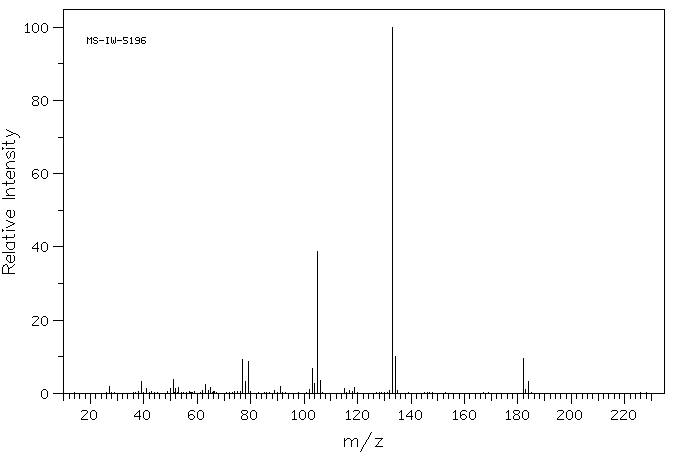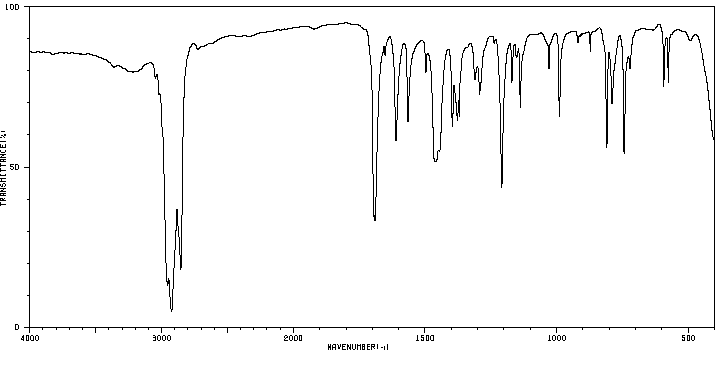2-氯-1-(2,4-二甲基苯基)乙酮 | 2623-45-2
中文名称
2-氯-1-(2,4-二甲基苯基)乙酮
中文别名
——
英文名称
2-chloro-1-(2,4-dimethyl-phenyl)-ethanone
英文别名
2-Chlor-1-(2,4-dimethyl-phenyl)-aethanon;1.5-Dimethyl-2-chloracetyl-benzol;2.4-Dimethyl-phenacylchlorid;ω-Chlor-2.4-dimethyl-acetophenon;Chlormethyl-(2.4-dimethyl-phenyl)-keton;α-Chlor-2,4-dimethyl-acetophenon;Ethanone, 2-chloro-1-(2,4-dimethylphenyl)-;2-chloro-1-(2,4-dimethylphenyl)ethanone
CAS
2623-45-2
化学式
C10H11ClO
mdl
MFCD00152345
分子量
182.65
InChiKey
SJMUGKXTDUSEOC-UHFFFAOYSA-N
BEILSTEIN
——
EINECS
——
-
物化性质
-
计算性质
-
ADMET
-
安全信息
-
SDS
-
制备方法与用途
-
上下游信息
-
文献信息
-
表征谱图
-
同类化合物
-
相关功能分类
-
相关结构分类
物化性质
-
熔点:62-63 °C
-
沸点:276.0±25.0 °C(Predicted)
-
密度:1.107±0.06 g/cm3(Predicted)
计算性质
-
辛醇/水分配系数(LogP):3
-
重原子数:12
-
可旋转键数:2
-
环数:1.0
-
sp3杂化的碳原子比例:0.3
-
拓扑面积:17.1
-
氢给体数:0
-
氢受体数:1
安全信息
-
海关编码:2914700090
SDS
SECTION 1: Identification of the substance/mixture and of the company/undertaking
Product identifiers
Product name : 2-Chloro-1-(2,4-Dimethylphenyl)Ethanone
: OTV000341
REACH No. : A registration number is not available for this substance as the substance
or its uses are exempted from registration, the annual tonnage does not
require a registration or the registration is envisaged for a later
registration deadline.
SECTION 2: Hazards identification
Classification of the substance or mixture
Classification according to Regulation (EC) No 1272/2008
Eye irritation (Category 2), H319
For the full text of the H-Statements mentioned in this Section, see Section 16.
Classification according to EU Directives 67/548/EEC or 1999/45/EC
Xi Irritant R36
For the full text of the R-phrases mentioned in this Section, see Section 16.
Label elements
Labelling according Regulation (EC) No 1272/2008
Pictogram
Signal word Warning
Hazard statement(s)
Causes serious eye irritation.
Precautionary statement(s)
P305 + P351 + P338 IF IN EYES: Rinse cautiously with water for several minutes. Remove
contact lenses, if present and easy to do. Continue rinsing.
Supplemental Hazard none
Statements
Other hazards
This substance/mixture contains no components considered to be either persistent, bioaccumulative and
toxic (PBT), or very persistent and very bioaccumulative (vPvB) at levels of 0.1% or higher.
SECTION 3: Composition/information on ingredients
Substances
Molecular weight : 182,65 g/mol
Hazardous ingredients according to Regulation (EC) No 1272/2008
Component Classification Concentration
2-Chloro-1-(2,4-Dimethylphenyl)Ethanone
Eye Irrit. 2; H319 <= 100 %
Hazardous ingredients according to Directive 1999/45/EC
Component Classification Concentration
2-Chloro-1-(2,4-Dimethylphenyl)Ethanone
Xi, R36 <= 100 %
For the full text of the H-Statements and R-Phrases mentioned in this Section, see Section 16
SECTION 4: First aid measures
Description of first aid measures
General advice
Consult a physician. Show this safety data sheet to the doctor in attendance.
If inhaled
If breathed in, move person into fresh air. If not breathing, give artificial respiration. Consult a physician.
In case of skin contact
Wash off with soap and plenty of water. Consult a physician.
In case of eye contact
Rinse thoroughly with plenty of water for at least 15 minutes and consult a physician.
If swallowed
Never give anything by mouth to an unconscious person. Rinse mouth with water. Consult a physician.
Most important symptoms and effects, both acute and delayed
The most important known symptoms and effects are described in the labelling (see section 2.2) and/or in
section 11
Indication of any immediate medical attention and special treatment needed
No data available
SECTION 5: Firefighting measures
Extinguishing media
Suitable extinguishing media
Use water spray, alcohol-resistant foam, dry chemical or carbon dioxide.
Special hazards arising from the substance or mixture
Nature of decomposition products not known.
Advice for firefighters
Wear self-contained breathing apparatus for firefighting if necessary.
Further information
No data available
SECTION 6: Accidental release measures
Personal precautions, protective equipment and emergency procedures
Use personal protective equipment. Avoid dust formation. Avoid breathing vapours, mist or gas. Ensure
adequate ventilation. Avoid breathing dust.
For personal protection see section 8.
Environmental precautions
Do not let product enter drains.
Methods and materials for containment and cleaning up
Pick up and arrange disposal without creating dust. Sweep up and shovel. Keep in suitable, closed
containers for disposal.
Reference to other sections
For disposal see section 13.
SECTION 7: Handling and storage
Precautions for safe handling
Avoid contact with skin and eyes. Avoid formation of dust and aerosols.
Provide appropriate exhaust ventilation at places where dust is formed.
For precautions see section 2.2.
Conditions for safe storage, including any incompatibilities
Store in cool place. Keep container tightly closed in a dry and well-ventilated place.
Storage class (TRGS 510): Non Combustible Solids
Specific end use(s)
Apart from the uses mentioned in section 1.2 no other specific uses are stipulated
SECTION 8: Exposure controls/personal protection
Control parameters
Components with workplace control parameters
Exposure controls
Appropriate engineering controls
Handle in accordance with good industrial hygiene and safety practice. Wash hands before breaks and
at the end of workday.
Personal protective equipment
Eye/face protection
Safety glasses with side-shields conforming to EN166 Use equipment for eye protection tested
and approved under appropriate government standards such as NIOSH (US) or EN 166(EU).
Skin protection
Handle with gloves. Gloves must be inspected prior to use. Use proper glove removal technique
(without touching glove's outer surface) to avoid skin contact with this product. Dispose of
contaminated gloves after use in accordance with applicable laws and good laboratory practices.
Wash and dry hands.
The selected protective gloves have to satisfy the specifications of EU Directive 89/686/EEC and
the standard EN 374 derived from it.
Body Protection
impervious clothing, The type of protective equipment must be selected according to the
concentration and amount of the dangerous substance at the specific workplace.
Respiratory protection
For nuisance exposures use type P95 (US) or type P1 (EU EN 143) particle respirator.For higher
level protection use type OV/AG/P99 (US) or type ABEK-P2 (EU EN 143) respirator cartridges.
Use respirators and components tested and approved under appropriate government standards
such as NIOSH (US) or CEN (EU).
Control of environmental exposure
Do not let product enter drains.
SECTION 9: Physical and chemical properties
Information on basic physical and chemical properties
a) Appearance Form: solid
b) Odour No data available
c) Odour Threshold No data available
d) pH No data available
e) Melting point/freezing No data available
point
f) Initial boiling point and No data available
boiling range
g) Flash point No data available
h) Evaporation rate No data available
i) Flammability (solid, gas) No data available
j) Upper/lower No data available
flammability or
explosive limits
k) Vapour pressure No data available
l) Vapour density No data available
m) Relative density No data available
n) Water solubility No data available
o) Partition coefficient: n- No data available
octanol/water
p) Auto-ignition No data available
temperature
q) Decomposition No data available
temperature
r) Viscosity No data available
s) Explosive properties No data available
t) Oxidizing properties No data available
Other safety information
No data available
SECTION 10: Stability and reactivity
Reactivity
No data available
Chemical stability
Stable under recommended storage conditions.
Possibility of hazardous reactions
No data available
Conditions to avoid
No data available
Incompatible materials
No data available
Hazardous decomposition products
In the event of fire: see section 5
SECTION 11: Toxicological information
Information on toxicological effects
Acute toxicity
No data available
Skin corrosion/irritation
No data available
Serious eye damage/eye irritation
No data available
Respiratory or skin sensitisation
No data available
Germ cell mutagenicity
No data available
Carcinogenicity
IARC: No component of this product present at levels greater than or equal to 0.1% is identified as
probable, possible or confirmed human carcinogen by IARC.
Reproductive toxicity
No data available
Specific target organ toxicity - single exposure
No data available
Specific target organ toxicity - repeated exposure
No data available
Aspiration hazard
No data available
Additional Information
RTECS: Not available
SECTION 12: Ecological information
Toxicity
No data available
Persistence and degradability
No data available
Bioaccumulative potential
No data available
Mobility in soil
No data available
Results of PBT and vPvB assessment
This substance/mixture contains no components considered to be either persistent, bioaccumulative and
toxic (PBT), or very persistent and very bioaccumulative (vPvB) at levels of 0.1% or higher.
Other adverse effects
No data available
SECTION 13: Disposal considerations
Waste treatment methods
Product
Offer surplus and non-recyclable solutions to a licensed disposal company. Dissolve or mix the material
with a combustible solvent and burn in a chemical incinerator equipped with an afterburner and scrubber.
Contaminated packaging
Dispose of as unused product.
SECTION 14: Transport information
UN number
ADR/RID: - IMDG: - IATA: -
UN proper shipping name
ADR/RID: Not dangerous goods
IMDG: Not dangerous goods
IATA: Not dangerous goods
Transport hazard class(es)
ADR/RID: - IMDG: - IATA: -
Packaging group
ADR/RID: - IMDG: - IATA: -
Environmental hazards
ADR/RID: no IMDG Marine pollutant: no IATA: no
Special precautions for user
No data available
SECTION 15: Regulatory information
This safety datasheet complies with the requirements of Regulation (EC) No. 1907/2006.
Safety, health and environmental regulations/legislation specific for the substance or mixture
No data available
Chemical Safety Assessment
SECTION 16 - ADDITIONAL INFORMATION
N/A
上下游信息
-
下游产品
中文名称 英文名称 CAS号 化学式 分子量 —— 2-(2,4-dimethylphenyl)-2-oxoethyl acetate 65143-39-7 C12H14O3 206.241
反应信息
-
作为反应物:描述:2-氯-1-(2,4-二甲基苯基)乙酮 在 sodium hydroxide 作用下, 以 N-甲基吡咯烷酮 、 水 为溶剂, 反应 6.5h, 生成 N-[4-(2,4-dimethylphenyl)-3-quinolin-2-yl-1H-pyrrol-2-yl]-2-ethylhexanamide参考文献:名称:JP5827901摘要:公开号:
-
作为产物:描述:参考文献:名称:Grignard; Perrichon, Annales de Chimie (Cachan, France), 1926, vol. <10> 5, p. 20摘要:DOI:
文献信息
-
DABCO-Catalyzed Reaction of α-Halo Carbonyl Compounds with Dimethyl Acetylenedicarboxylate: A Novel Method for the Preparation of Polysubstituted Furans and Highly Functionalized 2<i>H</i>-Pyrans作者:Mingjin Fan、Zeyi Yan、Weimin Liu、Yongmin LiangDOI:10.1021/jo050903g日期:2005.9.1Polysubstituted furans and highly functionalized 2H-pyrans were prepared in good yields by DABCO-catalyzed reactions of α-halo carbonyl compounds with dimethyl acetylenedicarboxylate (DMAD) at room temperature.
-
Simple and Efficient Procedure for the Friedel–Crafts Acylation of Aromatic Compounds with Carboxylic Acids in the Presence of P<sub>2</sub>O<sub>5</sub>/AL<sub>2</sub>O<sub>3</sub>Under Heterogeneous Conditions作者:Abdol R. Hajipour、Amin Zarei、Leila Khazdooz、Arnold E. RuohoDOI:10.1080/00397910802663436日期:2009.7.7Abstract An efficient and chemoselective method for the Friedel–Crafts acylation of aromatic compounds using P2O5/Al2O3 and carboxylic acids. Both aromatic and aliphatic carboxylic acids reacted easily to afford the corresponding aromatic ketones in good yields.
-
Friedel–Crafts acylation of aromatic compounds with carboxylic acids in the presence of P2O5/SiO2 under heterogeneous conditions作者:Amin Zarei、Abdol R. Hajipour、Leila KhazdoozDOI:10.1016/j.tetlet.2008.09.062日期:2008.11A convenient and efficient procedure for the Friedel–Crafts acylation of aromatic compounds with carboxylic acids in the presence of P2O5/SiO2 is described. Both aromatic and aliphatic carboxylic acids reacted easily to afford the corresponding aromatic ketones. The use of non-toxic and inexpensive materials, simple and clean work-up, short reaction times and good yields of the products are the advantages
-
Phenacyl ester photosensitizers for radiation-curable coatings申请人:American Cyanamid Company公开号:US04054719A1公开(公告)日:1977-10-18An ultraviolet radiation-curable composition is provided which comprises a polyethylenically unsaturated compound and effective photosensitizing amounts of (a) a phenacyl ester, and (b) a tertiary aliphatic amine.提供了一种紫外线辐射可固化组合物,其包括聚乙烯基不饱和化合物和有效光敏化量的(a)苯乙酰酯和(b)三级脂肪胺。
-
Joerlander, Chemische Berichte, 1917, vol. 50, p. 1460作者:JoerlanderDOI:——日期:——
表征谱图
-
氢谱1HNMR
-
质谱MS
-
碳谱13CNMR
-
红外IR
-
拉曼Raman
-
峰位数据
-
峰位匹配
-
表征信息
同类化合物
(反式)-4-壬烯醛
(s)-2,3-二羟基丙酸甲酯
([1-(甲氧基甲基)-1H-1,2,4-三唑-5-基](苯基)甲酮)
(Z)-4-辛烯醛
(S)-氨基甲酸酯β-D-O-葡糖醛酸
(S)-3-(((2,2-二氟-1-羟基-7-(甲基磺酰基)-2,3-二氢-1H-茚满-4-基)氧基)-5-氟苄腈
(R)-氨基甲酸酯β-D-O-葡糖醛酸
(5,5-二甲基-2-(哌啶-2-基)环己烷-1,3-二酮)
(2,5-二氟苯基)-4-哌啶基-甲酮
龙胆苦苷
龙胆二糖甲乙酮氰醇(P)
龙胆二糖丙酮氰醇(P)
龙胆三糖
龙涎酮
齐罗硅酮
齐留通beta-D-葡糖苷酸
鼠李糖
黑芥子苷单钾盐
黑海棉酸钠盐
黑木金合欢素
黑曲霉三糖
黑介子苷
黄尿酸8-O-葡糖苷
麻西那霉素II
麦迪霉素
麦芽糖脎
麦芽糖基海藻糖
麦芽糖1-磷酸酯
麦芽糖
麦芽四糖醇
麦芽四糖
麦芽十糖
麦芽六糖
麦芽五糖水合物
麦芽五糖
麦芽五糖
麦芽五糖
麦芽三糖醇
麦芽三糖
麦芽三糖
麦芽三塘水合
麦芽七糖水合物
麦芽七糖
麦法朵
麦可酚酸-酰基-Β-D-葡糖苷酸
麦利查咪
麝香酮
鹤草酚
鸢尾酚酮 3-C-beta-D-吡喃葡萄糖苷
鸡矢藤苷








